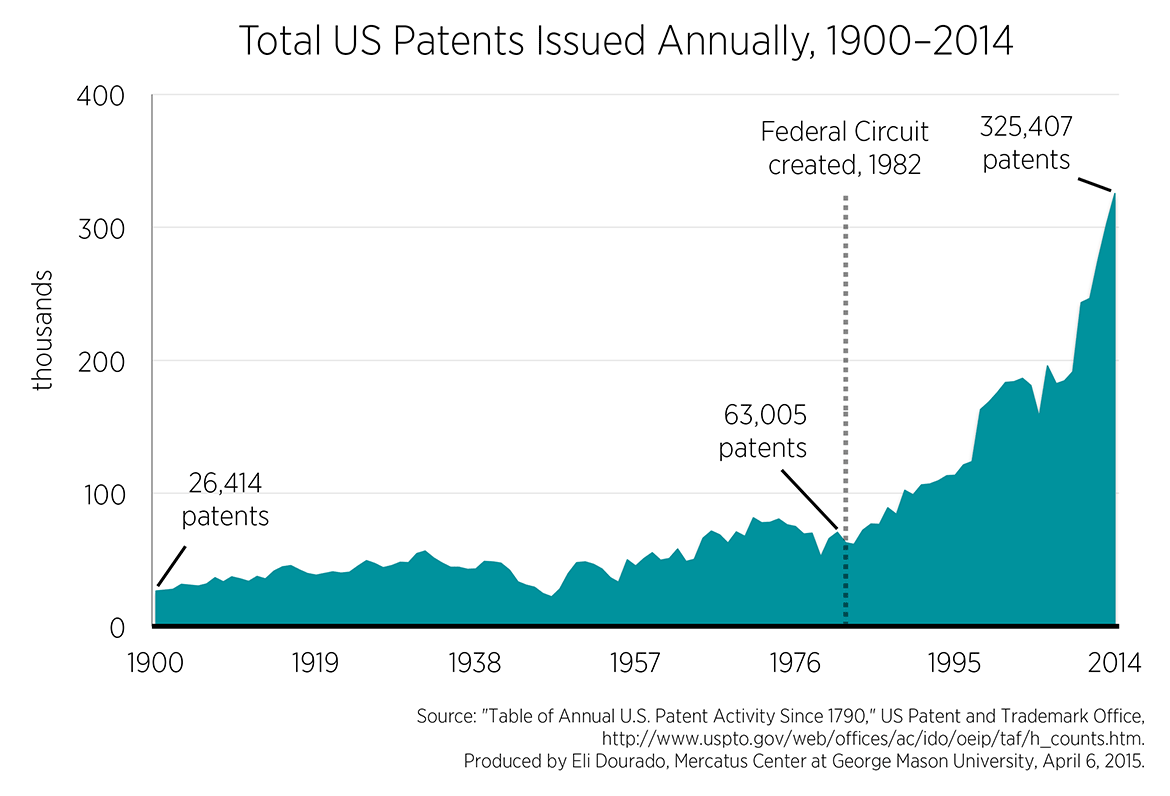- | Regulation Regulation
- | Data Visualizations Data Visualizations
- |
The Number of Patents Has Exploded Since 1982, and One Court Is to Blame
This week’s chart shows the sharp increase in the number of patents over the past three decades, using data from the US Patent and Trademark Office to display the total number of patents that have been extended from 1900 to 2014.
The US Constitution vests Congress with the power to extend patents to inventors to “promote the progress of science and useful arts.” In recent years, however, patents have too often hindered innovation and economic growth. Patents for trivial or non-original functions have served as a basis for groundless “troll” lawsuits against innocent parties. The number of these destructive patent claims dramatically increased after a special patent court was created in the 1980s. The patent problem has to be addressed at its roots to reinvigorate the nation’s innovative capacity.
This week’s chart shows the sharp increase in the number of patents over the past three decades, using data from the US Patent and Trademark Office to display the total number of patents that have been extended from 1900 to 2014.
Since the early 1980s, the number of patents issued by the US Patent and Trademark Office annually has quintupled. Many of these patents are low quality and not even valid under the most recent Supreme Court jurisprudence. For example, the Government Accountability Office (GAO) reports that more than half of all recent patents granted have been software-related, despite Supreme Court precedents in Parker v. Flook (1978), Bilski v. Kappos (2010), and Alice v. CLS (2014) that abstract ideas such as algorithms and computer programs are not eligible for patents.
In 1982 Congress consolidated all patent appeals into a single appeals court, the Federal Circuit. Shortly afterwards, there was an explosion of low-quality patents. The Federal Circuit has systematically changed the law, sometimes even undermining Supreme Court precedent, to favor patent interests. Economists Matthew Henry and John Turner analyzed a dataset of district and appellate patent decisions for the years 1953 to 2002 and report that patentees are three times more likely to win on appeal after a district court ruling of invalidity in the post-1982 era. The result has been an explosion of patents and patent litigation.
The chart above illustrates this history. From 1900 to 1982, the number of patents increased by around 138 percent. After 1982, the number of patents extended increased by an astounding 416 percent by 2014.
This explosion of patents has significantly dampened innovation and imposed considerable costs on entrepreneurs. Companies must now devote considerable resources to scouring the thicket of low-quality patent claims before bringing products to market. Even then, there is no guarantee that they won’t be sued for infringement. Our patent system now costs billions in legal research, litigation, and innovations foregone, according to studies of firms targeted by “patent trolls.”
Congress is now working to improve the symptoms of our patent problem by reforming patent litigation with the Innovation Act. Such reform is welcome, but to get to the root of the problem, Congress should also consider three more fundamental reforms. First, it should reform the system for patent appeals, reverting to the way that appeals work in almost every other area of the law: parties appeal to the circuit to which their federal district court is assigned. Second, Congress should remove patent protection for subject matter, like software and business methods, that have been abused by “patent trolls.” Finally, Congress should align the existing stock of patents with the latest Supreme Court jurisprudence, perhaps by establishing a program at the patent office to mark as invalid those patents previously issued that no longer conform with the Supreme Court’s rulings. These reforms would realign the use of patents in the spirit that the Founders intended—to promote, not prevent, innovation and economic flourishing.


